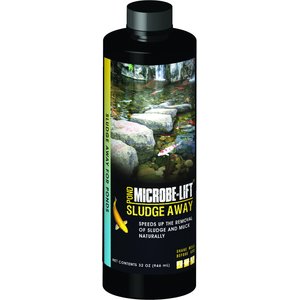3 Best Pond Sludge Removers Compared
Pond Academy is reader-supported. Buying through links on our site may earn us an affiliate commission. As an Amazon Associate I earn from qualifying purchases.
Pond sludge is a fact of life for most ponds. And in small amounts, it isn’t a big deal.
But as sludge accumulates, it can start to cause problems for your pond’s ecosystem and water quality.
So, let's learn exactly what sludge is, what causes it, and how to get rid of pond sludge and prevent it from returning.
And, to save you time, we’ll cover the best pond sludge removers available today to help you get your muck problems in check quickly and easily.
Pond Sludge Remover Comparison
| Description | Type | Price | ||
|---|---|---|---|---|

|
API Pond-Zyme Sludge Destroyer | Natural Bacteria Removal | ||

|
Microbe-Lift Sludge Away | Natural Bacteria Removal | ||

|
Oase Pondovac Classic Pond Vacuum Cleaner | Mechanical Removal |
*Buying through links in this chart may earn us a commission at no additional cost to you.
Get Our Best Pond Tips Sent to Your Inbox for Free!
Join thousands of others and learn from our decades of pond building and maintenance experience! Your pond will thank you!
By subscribing you agree to receive emails from PondAcademy.com. We will always respect your privacy and you can unsubscribe at any time.
Best Pond Sludge Remover Reviews
If you’re noticing a build-up of sludge and muck in your pond, you’ll definitely want to remove it (at least mostly) before it leads to serious issues.
We will first cover three of the best pond muck remover products on the market today, then in the next section, we’ll explain exactly how to remove the sludge.
API Pond-Zyme Sludge Destroyer
API Pond-Zyme Sludge Destroyer is a simple and effective pond cleaner used to reduce sludge and fish waste in ponds.
The natural active ingredients (bacteria and barley) are designed to break down algae, grass clippings, and other organic debris that contributes to the sludge on the floor of your pond.
Regular use of this product will help reduce the overall time you spend on pond maintenance and keeping your pond water clean.
Simply dose your pond for two weeks in Spring and two weeks in Fall, and once every two weeks for regular pond maintenance.
Benefits of Pond-Zyme Sludge Destroyer
- Effective pond sludge remover
- Reduces build-up of fish waste
- Natural active ingredients, including beneficial bacteria and barley
- Reduces time spent on pond maintenance
- Safe for fish, pets, and wildlife
Microbe-Lift Sludge Away
Microbe-Lift Sludge Away rapidly removes sludge and muck naturally. In fact, they claim it reduces sludge 80% faster than the competition.
This organic and microbial-based product is made of 100% active ingredients. It is especially helpful for a rock or gravel pond bottom (which makes it hard to remove sludge with a pond vacuum or other means).
This product is safe for fish, plants, and other aquatic wildlife. Just be sure to have a proper aeration system in your pond.
Benefits of Microbe-Lift Sludge Away
- Rapid and natural pond sludge remover
- Improves pond water clarity
- Works great for ponds with rock and gravel floors
- Safe for fish, plants, and other aquatic wildlife
Pond Sludge Vacuum
Unlike the two bacteria-based removers above, a pond vacuum cleaner provides an extremely quick and effective way to get rid of large amounts of pond sludge.
And the Oase Pondovac Classic pond vacuum is one of the best pond vacuums on the market for the money.
While a pond vacuum cleaner may be more expensive upfront than bacteria-based removers, they pay for themselves over time as you can continually use them year after year (instead of continually buying sludge removers).
Plus, pond vacuums have many cleaning uses and can even drain a pond.
Benefits of A Pond Muck Vacuum
- Removes pond sludge immediately
- Effective for removing large amounts of pond sludge
- Hose attachments make it easy to get sludge, muck, and silt from nooks and crannies in your pond
- Has many other cleaning uses
What Is Pond Sludge?
Pond sludge, also known as pond muck, is the accumulation of organic debris that has sunk to the bottom of your pond. This debris, over time, slowly decomposes into a sludge-like substance that covers the pond floor.
Small amounts of this sludge aren’t a big deal, but as it accumulates, more and more harmful substances are released into your pond.
High levels of these harmful substances (ammonia and nitrites) can cause issues with water quality, fish health, and your entire pond ecosystem.
What Causes Pond Sludge?
So, we know that pond sludge is an accumulation of organic debris that has decomposed on the bottom of your pond. But what are the major causes of this debris? The common culprits include:
- Tree and plant leaves and other vegetation falling or blowing into your pond are arguably the biggest culprits.
- Pond plants can also contribute to the muck on the bottom of your pond as their decaying leaves fall into the water.
- Fish ponds have to deal with fish waste and excess fish food sinking to the bottom and causing sludge issues. Koi ponds especially create a lot of waste.
- Dead algae that haven’t been cleaned up has nowhere to go but down, thus decomposing into sludge.
Most likely, if you have pond sludge issues, it will be a mixture of the causes above.
How to Remove Pond Sludge
There are two main ways to remove sludge from a pond: bacterial pond sludge removers (natural bacteria removal) and physically removing the sludge from your pond using a tool (mechanical removal).
Let’s look at how to clean sludge out of a pond using each method.
Natural Bacteria Sludge Removal
A popular method of pond sludge removal is with natural bacteria and enzyme-based removers like the above-mentioned API Pond-Zyme Sludge Destroyer and Microbe-Lift Sludge Away. Natural pond sludge removers are popular because of their ease of use and effectiveness.
For the best pond muck removal results, apply the product in early Spring and at the end of the season in Fall.
Be sure to choose a sludge remover that works in a wide range of temperatures (like the two in our list above). Some products are only designed for warm-temperature use. Keep in mind, however, that whether they are rated for cold temperature use or not, they will typically work better in warmer temps. And we mean pond temperature, not air temperature.
We also recommend that you run a pond aerator to ensure your pond is richly oxygenated for the bacteria to effectively do their job.
![]() Important
Important
Always read the product label for specific directions for the product you are using.
Mechanical Muck Removal
Another popular pond sludge removal method is to physically remove it with a pond vacuum.
While this option may be more expensive up-front and more hands-on, it offers several distinct advantages over bacteria-based removers.
First of all, pond vacuums work immediately. For backyard ponds, you can effectively remove the bulk of the sludge within a few short hours (though this might not be a feasible option for large farm ponds and lakes).
They are also great at getting rid of large sludge build-ups that pond bacteria removers would take months to get rid of (if they could at all).
Plus, pond vacuums are a great all-around tool, and I highly recommend every pond owner has one. Check out our detailed Pond Vacuum guide to find the best vacuum for your specific pond.
![]() Did You Know...
Did You Know...
Pond sludge is good for the garden! When you suck up pond sludge with a vacuum, you can discharge it into your garden to help fertilize your plants.
What's the Best Pond Sludge Remover?
So, we learned about bacteria-based removal and mechanical removal, but which method is best to eliminate pond sludge?
The best pond sludge remover is a combination of natural bacteria removal and mechanical removal. Applying a natural bacteria and barley-based product like API Pond-Zyme with regular cleanings using a pond vacuum will help keep your pond muck free.
In other words, using a pond vacuum to remove the most of the sludge and muck from the bottom of your pond, then controlling any additional build-up with regular doses of a natural bacteria sludge remover, will certainly give you the results you are after.
You can even take it further with a few preventative measures, as well!
How to Prevent Sludge From Returning
Once you’ve removed the pond sludge, it’s a good idea to put a few preventative measures in place to help keep it from returning.
Pond Netting
Since the main cause of sludge is outside debris entering the pond and sinking to the bottom, we can help alleviate this with pond netting.
Pond netting is a net you place over your pond to protect it from leaves and other debris. The debris will get caught in the net before it can sink to the bottom and decompose.
And as an added benefit, they help protect your fish pond from predators!
Pond netting comes in many different types, each serving a specific purpose, so check out our Pond Netting guide to get the right net for your pond or water garden.
Pond Skimmers
Like pond netting, a pond skimmer helps remove outside debris from your pond before it can sink and decompose.
Pond skimmers essentially sit on the surface of your pond and draw pond water in and through its built-in filter. It traps any debris it sucks in and returns the clean water to your pond.
Pond skimmers are more expensive than pond netting, but they are practically invisible and help complement a pond filtration system.
Check out our Pond Skimmer guide to find the perfect skimmer for your pond!
Pond Aeration
Adding oxygen to your pond water can help ensure that your bacteria levels are maximized and help them to more efficiently break down debris and harmful substances.
Pond aerators, fountains, pond spitters, and even pond plants will all help oxygenate your pond so your bacteria can thrive.
Beneficial Bacteria
As mentioned above, beneficial bacteria are important to help break down the debris and harmful substances in your pond. By adding a beneficial bacteria product to your pond, you can ensure that your pond's bacteria levels are high to prevent pond sludge, improve your pond's water quality, and even reduce pond filter maintenance.
This is typically only required if you have low bacteria levels for a specific reason, like after a water change or after using a pond algaecide.
Check out my post on Beneficial Bacteria products to see if they are right for your pond.
Regular Pond Maintenance
Probably the most obvious tip to prevent sludge and muck is simple pond maintenance.
By regularly cleaning your pond, removing surface debris, cleaning out your filters and skimmers, checking water quality with a pond water test kit, and controlling pond algae, you’ll be able to effectively prevent, or at the very least, slow down the accumulation of sludge on the floor of your pond.











